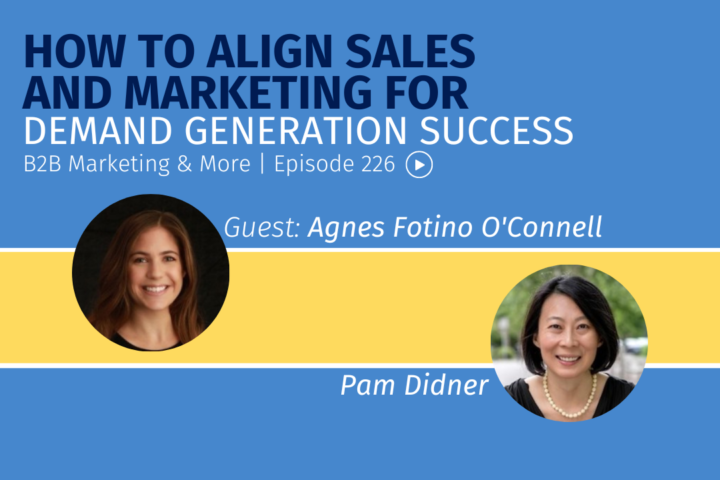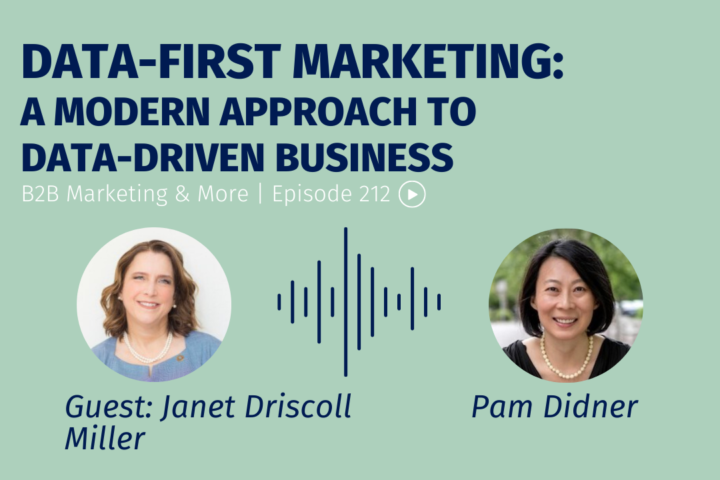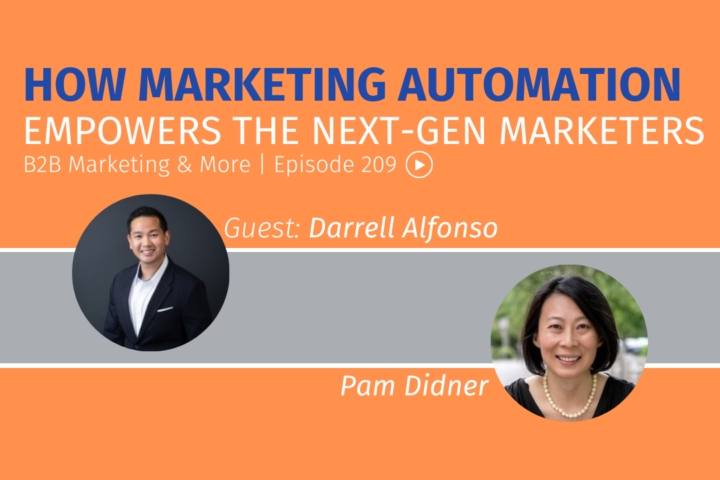
A big hello from Raleigh, North Carolina. In today’s episode of B2B Marketing & More, I explain how to set up an efficient and cohesive martech stack. I’ll guide your thinking approach and break down key steps that you can take to tackle this hairy issue.
In this episode:
- What makes martech Stack complicated
- What is the best way to navigate the martech stack
- How to plan your martech budget
- How to build a martech stack
- Why and how to include paid media in your marketing
Quotes from the episode:
“Knowing your business objectives and the marketing channels you want to use, and the success metrics you’re looking for will all go a long way on Martech Stack building. ”
“You can grow your business organically to some extent. However, at some point, you will hit the ceiling. If you need to grow, you need to do paid advertising, which means paid search, paid ads, or even paid sponsors.“
—————
Enjoy the podcast? Subscribe to the show on your favorite podcast platform, leave a 5-star review and subscribe to Apple Podcasts.
If you prefer watching a video, I also have a YouTube Channel; check it out and subscribe.
If you want to chat, reach out to any social media channels or email me at hello@pamdidner.com. You can also join my Facebook community: Build Your Marketing Skills to Get Ahead. When you join, you get a free Starbucks on me. You can go to the Announcement tab and click on the barcode of the gift card.
To expand your knowledge on how to navigate martech stack, check out some of my previous podcast episodes, blog posts, and video.
Podcast episodes
MarTech in Practice: Opportunities, Trends, and Challenges
How to Create and Evaluate Your MarTech Stack?
How to Understand Your Company’s MarTech Stack?
Blog post
Making Martech Stack Manageable – 3 Things To Know
How to Use Artificial Intelligence in Marketing
Video
How to Implement AI into Your Marketing for your Business | Tools & Strategy Pitch
TRANSCRIPT
A big hello from Raleigh, North Carolina. A small business owner, Sean, reached out to me and asked how to set up an efficient and cohesive Martech Stack for his company. That’s a loaded question. That’s the question I’d like to address at this month’s SOLO episode.
I’ll guide your thinking approach and break down key steps that you can take to tackle this hairy issue.
Yes, you can do this!
And if you like the way I explain the approach or steps, please subscribe to your favorite listening platform. Again, if you have any questions, you know how to reach me at hello@pamdidner.com.
Now, let me give you a little background info about Sean:
He and his two business partners sell an Irish dance music streaming application named Feis (Fesh). Their growth has been almost solely organic, with next to no marketing plan or data collection in place. However, they recognize that continued growth hinges on the implementation of Martech infrastructure.
The more Sean reads about various marketing technologies, the more he is overwhelmed by the information.
By a stroke of luck, he found me on the Internet and scheduled a call with me. He wanted to know how to tackle the Martech Stack.
Here are the three elements I shared with Sean; I thought you might find them useful, they will help you navigate martech stack:
1. Martech Stack is inherently complicated. The best way to navigate it is to know exactly what you need to build
I told him to get together with his two partners to do that. Go to a pub, a coffee shop, or another comfortable place to have in-depth conversations about business objectives and marketing goals. It was important for them to hammer out what they wanted to accomplish and how they tried to measure their marketing success. You can’t do marketing unless you have good products; first, he is taking care of that, and the next is to craft business objectives and goals accordingly.
Once all three partners could agree on their business objectives and models, they would need to determine which channels they would use to achieve their marketing outreach. FB, Email, Spotify, Podcast advertising, whatever it may be.
So, here is one example I shared with him. Was the goal to grow their FB community? Should they do FB ads and drive traffic to their community that way if that were the case?
I told Sean that there are many ways to reach out to potential customers. He would need to think through which specific channels he wanted to use for marketing outreach.
Once you know that information, you can work backwards to build your Martech specifically for those channels.
In addition, he would need to know what customer data he would like to collect and what success metrics he’d like to measure.
Customer outreach channels, customer data collection, and success metrics, will all help guide him through the Martech Stack process.
If you know what you want, suddenly, you can self-filter out many Martech technologies that will not apply to you.
You can also explain to vendors what you want to do and give them ideas on how they can help you. Then, you’ll realize the Martech Stack isn’t as intimidating as it seems. It doesn’t mean it’s not hard; it just means that now you know what to look for.
Knowing your business objectives and the marketing channels you want to use, and the success metrics you’re looking for will all go a long way on Martech Stack building.
2. Know that it takes time and money to build Martech
Here is another thing I shared with Sean. Digital takes time to do right. Once you build a flow, you need to test it to make sure it works. 90% of the time, it doesn’t work the first go-round. Also, the workflow needs to connect several systems through API integrations or data migration. Oh, and be aware that data may not migrate correctly, or API can break. When you try to connect different systems or technologies, suddenly, everything becomes very fragile.
At the same time, technologies are not cheap. You need to set aside money to build your Martech. There is no magic shortcut, unfortunately. I am an individual consultant, and people are often shocked by how much money I spend on technologies. But, unfortunately, there is no other way around it.
3. Paid media needs to be part of the marketing strategy
This is a harsh reality for small businesses to understand. You can grow your business organically to some extent. However, at some point, you will hit the ceiling. If you need to grow, you need to do paid advertising, which means paid search, paid ads, or even paid sponsors. Paid is an essential part of marketing. The challenge is that you can’t do paid effectively with a one-off campaign or one-off effort. It needs to be sustainable over a long period of time. Marketing is a journey, not a sprint. I do marketing every day – it can be an interview, doing a live video like now, or as simple as writing a single LinkedIn post or a short tweet. The point is marketing doesn’t stop. Ever.
People often ask me how much they should spend on paid. That is subject to discussion, but, in general, it needs to be a decent amount to make an impact on whatever you are tracking.
Let me give you a simple example:
When you do paid, you will calculate your cost per marketing lead or cost per acquisition. Say if you pay $3 per podcast download, you know how much you need to spend if you want to have 20,000 downloads. (Ok, that’s $60,000, not cheap, right?)
When I did Facebook paid ads to promote my workshop several years ago, the conversion to purchase my workshop was $180. I am not talking about driving traffic to my website; I am talking about the people who registered and paid for my workshop. So, If I wanted 50 attendees, you can easily calculate that my projected promotion was about $9000.
Paid, in general, is not cheap. Organic referral and word of mouth are the best ways to get customers, but building your referrals and word of mouth takes time.
To bring it back to Sean, we had a great conversation together. I gave him enough steps and ideas to think about what he needs to do as the next steps.
If you are in the process of building your Martech Stack, let me know what your process is like. Is there overlap with what I’ve described, or is there anything different? Let’s learn from each other.
Again, I hope you enjoy today’s SOLO episode, and I provide some ideas to approach your Martech stack building.
Don’t forget to subscribe. Take care, bye.



